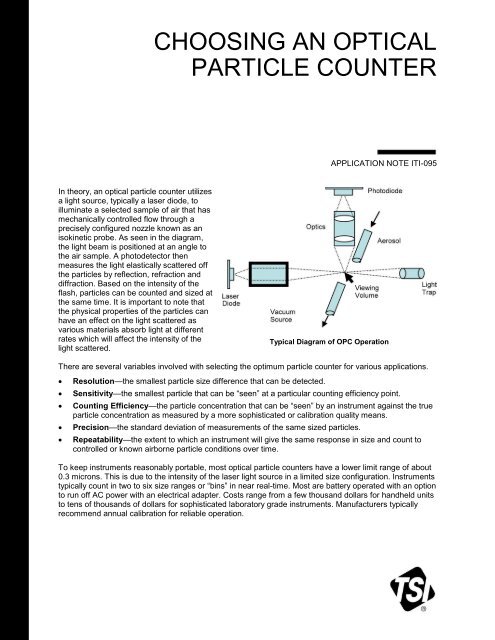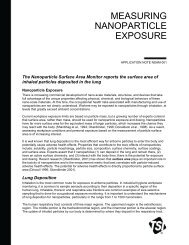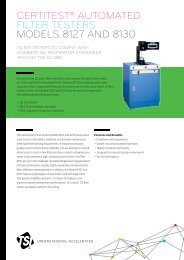Application Note ITI-095 Choosing an Optical Particle Counter - TSI
Application Note ITI-095 Choosing an Optical Particle Counter - TSI
Application Note ITI-095 Choosing an Optical Particle Counter - TSI
Create successful ePaper yourself
Turn your PDF publications into a flip-book with our unique Google optimized e-Paper software.
In theory, <strong>an</strong> optical particle counter utilizes<br />
a light source, typically a laser diode, to<br />
illuminate a selected sample of air that has<br />
mech<strong>an</strong>ically controlled flow through a<br />
precisely configured nozzle known as <strong>an</strong><br />
isokinetic probe. As seen in the diagram,<br />
the light beam is positioned at <strong>an</strong> <strong>an</strong>gle to<br />
the air sample. A photodetector then<br />
measures the light elastically scattered off<br />
the particles by reflection, refraction <strong>an</strong>d<br />
diffraction. Based on the intensity of the<br />
flash, particles c<strong>an</strong> be counted <strong>an</strong>d sized at<br />
the same time. It is import<strong>an</strong>t to note that<br />
the physical properties of the particles c<strong>an</strong><br />
have <strong>an</strong> effect on the light scattered as<br />
various materials absorb light at different<br />
rates which will affect the intensity of the<br />
light scattered.<br />
CHOOSING AN OPTICAL<br />
PARTICLE COUNTER<br />
APPLICATION NOTE <strong>ITI</strong>-<strong>095</strong><br />
Typical Diagram of OPC Operation<br />
There are several variables involved with selecting the optimum particle counter for various applications.<br />
Resolution—the smallest particle size difference that c<strong>an</strong> be detected.<br />
Sensitivity—the smallest particle that c<strong>an</strong> be ―seen‖ at a particular counting efficiency point.<br />
Counting Efficiency—the particle concentration that c<strong>an</strong> be ―seen‖ by <strong>an</strong> instrument against the true<br />
particle concentration as measured by a more sophisticated or calibration quality me<strong>an</strong>s.<br />
Precision—the st<strong>an</strong>dard deviation of measurements of the same sized particles.<br />
Repeatability—the extent to which <strong>an</strong> instrument will give the same response in size <strong>an</strong>d count to<br />
controlled or known airborne particle conditions over time.<br />
To keep instruments reasonably portable, most optical particle counters have a lower limit r<strong>an</strong>ge of about<br />
0.3 microns. This is due to the intensity of the laser light source in a limited size configuration. Instruments<br />
typically count in two to six size r<strong>an</strong>ges or ―bins‖ in near real-time. Most are battery operated with <strong>an</strong> option<br />
to run off AC power with <strong>an</strong> electrical adapter. Costs r<strong>an</strong>ge from a few thous<strong>an</strong>d dollars for h<strong>an</strong>dheld units<br />
to tens of thous<strong>an</strong>ds of dollars for sophisticated laboratory grade instruments. M<strong>an</strong>ufacturers typically<br />
recommend <strong>an</strong>nual calibration for reliable operation.
<strong>TSI</strong> Incorporated – Visit our website www.tsi.com for more information.<br />
USA Tel: +1 800 874 2811<br />
UK Tel: +44 149 4 459200<br />
Fr<strong>an</strong>ce Tel: +33 4 91 11 87 64<br />
Germ<strong>an</strong>y Tel: +49 241 523030<br />
-2-<br />
High flow counters, typically 1 cfm or 28.3 L/min offer adv<strong>an</strong>tages in certain situations. There are even<br />
some 2 cfm (nominal) or 50 L/min units on the market. The high flow rate instruments are for conditions<br />
where a large volume of air needs to be <strong>an</strong>alyzed. Usually the particle size resolution is reduced <strong>an</strong>d the<br />
ability to detect small particles is reduced due to a decreased signal to noise ratio. These units, though<br />
considered portable, tend to be somewhat bulkier <strong>an</strong>d heavier to accommodate the larger volume pump<br />
<strong>an</strong>d batteries to support operation.<br />
Low flow counters, typically 0.1 cfm or 2.83 L/min offer clear adv<strong>an</strong>tages where less air volume is needed<br />
such as in spot checks. The lower flow rate allows for smaller particles to be detected as they are in the<br />
viewing window longer. This also allows for higher concentrations to be measured. M<strong>an</strong>y of these low flow<br />
instruments are h<strong>an</strong>dheld, lightweight <strong>an</strong>d battery operated.<br />
<strong>Application</strong>s where particle size <strong>an</strong>d count are needed include:<br />
Aerosol research<br />
Industrial hygiene<br />
Personal exposure monitoring<br />
Indoor air quality assessment<br />
Environmental studies such as EPA compli<strong>an</strong>ce<br />
Verifying removal efficiency in filters or air cle<strong>an</strong>ers<br />
Process concentration fluctuation<br />
<strong>Particle</strong> source identification<br />
Yield improvement in precision m<strong>an</strong>ufacturing processes<br />
Verifying equipment perform<strong>an</strong>ce as in building m<strong>an</strong>agement<br />
Meeting specification such as air filter ratings<br />
Meeting regulations or certification as with cle<strong>an</strong>rooms, safety cabinets, fume hoods or in<br />
pharmaceutical preparation<br />
Quality assur<strong>an</strong>ce<br />
Clear<strong>an</strong>ce verification such as HVAC system cle<strong>an</strong>ing<br />
Verifying environmental controls such as paint booth exhaust<br />
Monitoring particle migration from construction or remodeling<br />
Selecting the optimum particle counter for a given application depends on the import<strong>an</strong>ce of these<br />
situational conditions. A person may choose ruggedness <strong>an</strong>d long term repeatability over precision when<br />
doing environmental studies, for example. While <strong>an</strong>other person may elect sensitivity <strong>an</strong>d efficiency in a<br />
highly sensitive semiconductor m<strong>an</strong>ufacturing area where even slight fluctuations in ambient conditions<br />
may greatly impact quality <strong>an</strong>d yield.<br />
India Tel: +91 80 67877200<br />
China Tel: +86 10 8251 6588<br />
Singapore Tel: +65 6595 6388<br />
<strong>ITI</strong>-<strong>095</strong> Rev. B ©2013 <strong>TSI</strong> Incorporated Printed in U.S.A.




